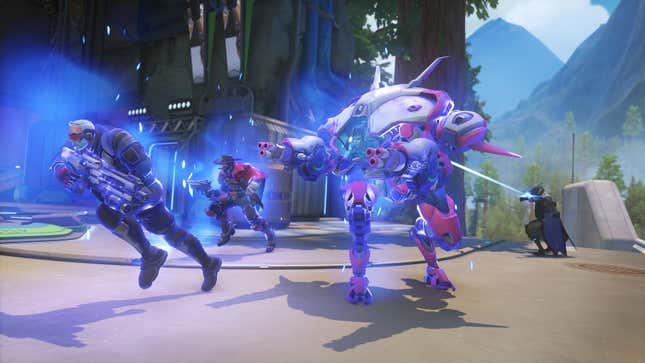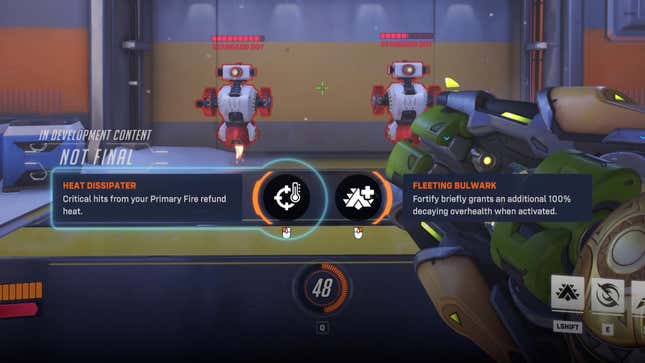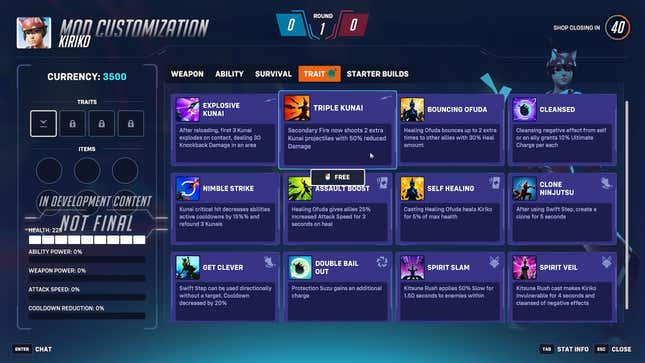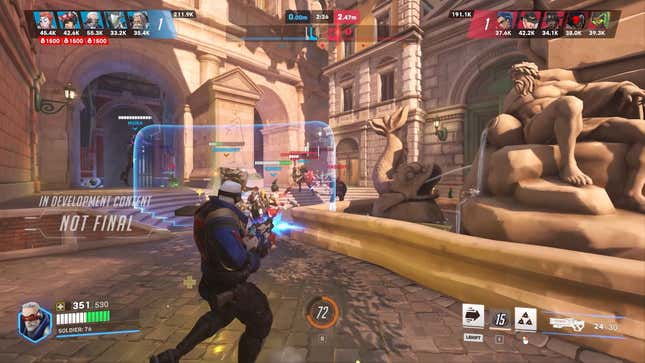
I never thought I’d become a lapsed Overwatch 2 player, but that’s what I’ve been lately. I barely touched season 14, and that lack of interest was the culmination of years of stagnation and broken promises finally pushing me away. Yeah, Marvel Rivals also showed up and took my time, but even if Overwatch’s most competent competitor in years hadn’t come out, I don’t know that I would have stuck with Blizzard’s hero shooter for much longer. And I don’t think I’ve been alone in feeling that way. For several seasons Blizzard has relied on expensive cosmetics and the occasional high-profile collaborations to hold players’ attention. The game is in desperate need of a change, lest the once-megalithic shooter find itself completely irrelevant in the volatile live-service market. After spending a few hours playing the new Stadium mode and messing around with the MOBA-like Perks system, I’m cautiously optimistic that Blizzard is finally getting the game on the right track.
In talking with developers about all the changes coming to Overwatch 2, I came away from the Blizzard campus feeling like the team had finally stopped being so precious about what the Overwatch experience is and decided to start experimenting with what it could be. I’ve spent hundreds of hours playing characters like Soldier: 76, Sombra, and Lifeweaver, and their kits are embedded into my muscle memory. Unless a hero has received a major rework, most characters in Overwatch have played pretty much the same way for years. Strategies form based on one defined playstyle, metas with “optimal” team compositions develop, and eventually, players get into a monotonous groove. Blizzard and Overwatch fans have spent so long arguing over things like bringing back the 6v6 format and balancing heroes in a particular way that any thought of what could actually reinvigorate the game had fallen by the wayside.

Going back to the 6v6 format was never going to be the shot in the arm a game that has lost this much cultural cache needed. What might work, however, are some of the changes Blizzard is bringing to the core Overwatch game, as well as the introduction of the new Stadium mode, which is unlike anything we’ve ever seen in the shooter before. But before we tackle that monster, let’s start with Perks, the new system being added to the base Overwatch 2 experience you know and love. These are tweaks to existing abilities that can fundamentally change how a hero is played. I was only able to play with a handful of heroes to test out their new kits, but I was pleasantly surprised at how the smallest change can make a hero feel very different.
Take, for example, Ramattra. The tank thrives in multiple scenarios as he swaps between his more poke-driven defensive form and his brawler Nemesis form. When I was able to pick between two of his Perks, I was given the option to turn his Ravenous Vortex ability—which has him fire off an orb that typically grounds airborne enemies where it lands and does light damage over time—into something else entirely. This included having the projectile explode if it made direct contact with an enemy, dragging them to the ground with some more precision, or allowing Ramattra to heal himself if he stood inside the vortex. As someone who wants his tank to be capable of sustaining as much damage as possible, the latter was much more appealing to me. But if I’d been facing a pesky flight-based hero like Pharah, I could see myself going the other route. Adapting to the situation in front of you is core to the Overwatch experience, as switching between heroes is a pillar of how you play. But with Perks, those adaptations can finally come from within a hero’s kit.
Another hero I played with was Orisa, who has undergone significant changes from the more stationary, defense-driven tank she was in the original Overwatch. I have adapted to her brawling, battering-ram-style kit in Overwatch 2, but I miss throwing down a barrier and holding space for my team. Something interesting Blizzard is doing with Perks is bringing back old abilities that have been missing from some heroes’ kits for years. Orisa can swap out her Javelin and get her old shield back. Bastion can self-heal again after losing the ability in his Overwatch 2 rework. The idea that old kits could be reintegrated into Overwatch 2 is one of the most exciting things about Perks because so many of Overwatch’s heroes have lost some of that creative spark that made them appealing in the first place.
Sombra was once one of my favorite heroes to play, but thanks to some frustrating reworks that have sanded down what made her stand out in the growing roster I’ve played her less and less. Overwatch 2 has become so fixated on forcing players to carry out team fights the “right” way that the creativity and skill expression of certain heroes have been lost. Perks feel like a correction because not only is it allowing heroes to find new utility, but it’s putting choices in the player’s hands, rather than watering down heroes in pursuit of “balance” and “fairness.”

If Perks are about giving players a chance to build out their favorite hero’s kit to their liking, Stadium is that philosophy cranked up to 11. Blizzard says the new mode is meant to be the third pillar alongside Quickplay and Competitive, and its retooling of Overwatch’s gameplay loop is one of the most exciting changes Blizzard is implementing. Stadium is a 5v5 mode that takes away one of the cores of Overwatch by locking you into one hero for the duration of a match. Instead of swapping between heroes for its seven rounds, you’ll spend the entire match focusing on creating a custom build for one character. At the beginning of each round, you’ll redeem earned currency to buy Mods that can give your hero of choice buffs, tweak their abilities, and possibly completely redefine how the character functions.
I was able to play a few matches as both Soldier: 76 and Kiriko. Having played most of my Overwatch matches as the grumpy gay grandpa, I was most curious about what directions Blizzard would let me take him, as the team says the goal of Stadium is to capture the “fantasy” of each hero, dialing their capabilities up to almost absurd levels. The Mods I picked for Soldier leaned into making him a bit more of a brawler. I upped his health and gave him armor, but I also changed his healing station from a placeable tool to one that radiated from him as I pushed forward alongside my team.
Kiriko, meanwhile, was the hero with whom I saw the absurd fantasy Blizzard’s going for most clearly. In base Overwatch 2, the support hero is able to teleport next to a teammate to give them some healing, but Stadium allowed me to Mod a different kind of teleport into her kit that didn’t require a target, and could reach much farther away than it would have with that restriction. I could retreat quickly from a tough situation, or pop up next to an unsuspecting enemy to throw a kunai right between their eyes. These are only a few examples of how Stadium lets you alter how a hero plays, and it’s a bit of a bummer that it will only launch with a select 14 heroes because there are so many characters I want to see reach this potential.

Even if I end up becoming a Soldier one-trick again, Stadium allows me to reconsider what I think an Overwatch hero can and should be after years of Blizzard defining that for us. Even things I think are a net positive for the game like the option of Role Queue (I just need to know I’ll have a support hero on my team, sorry) are based on trying to restrict how people play, so Blizzard giving this much freedom and control to players is the most exciting thing about Overwatch 2 right now.
Blizzard has spent so many years trying to wrangle the game into a polished, pristine competitive product that it almost lost sight of why anyone cared about it in the first place. Stadium and Perks feel like Blizzard finally letting go of the reins and letting players roam free and make their own destiny. Will Perks be enough to put the game back on top? Can Stadium get rid of the bad taste in my mouth left by the company reportedly canceling the story mode we were promised? Only if Blizzard commits to this new direction, rather than falling back into the restrictive mindset that has alienated players over the years.